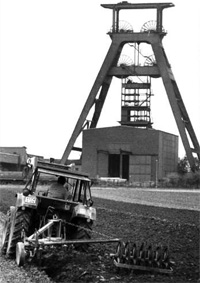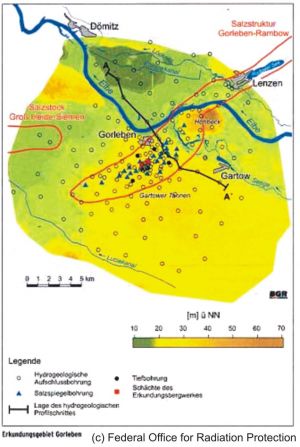Schacht Konrad
Information on the Final Repository Schacht KONRAD
Introduction
Schacht KONRAD, the Konrad pit, is a decommissioned ore mine in the industrial heart of the steel city Salzgitter. Between 2013 and 2080, it is envisaged to deposit 303,000 m³ of solid or solidified radioactive waste with negligible thermal activity in this mine and keep them safe for a million years. This includes waste from nuclear reprocessing that contains plutonium, as well as operational waste from the energy industry and nuclear research. The federal government expects that the portion of nuclear waste from medical applications will lie in the order of a thousandth. These 303,000 m³ may contain 865 kg of plutonium.
20,000 industrial jobs and high-grade agricultural areas are located in the immediate vicinity of KONRAD.
Time Line
- 1957-65 Drilling and construction of the ore mine Schacht KONRAD.
- 1965-76 Mining activity – from the start, the iron ore mining is under high financial and rationalization pressure (1,000 - 1,300 m depth, sour ore, Fe-content >33%) and is stopped again in October 1976 after only 10 1⁄2 operational years. The works council proposes to use the mine for other purposes, such as the storage of problematic waste.
- 1976-82 Exploration – Schacht KONRAD is examined for its suitability as repository for low level radioactive waste and large size components from the dismantling of nuclear power plants.
- 31/08/82 Application for the initiation of a plan approval procedure. As reaction the so far largest demonstration against the project takes place with 12,000 participants on October 30, 1982.
- 1985/86 Fundamental extension of the plan application. The criterion for the reposition is changed from dose rate (low and intermediate level) to degree of thermal activity: The surrounding host rock should not be warmed by more than 3 degrees. This would allow to deposit 95 % of the German radioactive waste in KONRAD.
- 1991 The federal administration issues a directive to force the public display of the plan documents; across Germany 289,387 objections are entered that are delivered to Hanover on July, 13, with a convoy of tractors and handed over to Monika Griefahn, then environmental Minister of the state Lower Saxony.
- 1992/93 Between September '92 and March '93, a 75-day marathon hearing takes place preluded by a demonstration with 7,000 people rallying against KONRAD.
- 2000 For the atomic treaty the federal government and the nuclear energy industry agree on an approval of KONRAD.
- 22/05/02 The state approves the plan. The environmental Minister of Lower Saxony, Jüttner (SPD), and the Federal Minister for the Environment, Trittin (Green Party), blame each other for being responsible.
- 2002-07 Law suits entered by an agricultural family and three municipalities fail first at the OVG (higher administrative court) Lüneburg, and later at the BVG (federal administrative court) in Leipzig. Both farmer Traube and the city of Salzgitter enter a constitutional appeal that, however, has no further dilatory effect. The appeal of the city Salzgitter is rejected, while the decision in the second case has not yet been issued.
Safety Concerns
For decades pre-eminent geologists have contended that the Gorleben salt dome would not be a safe final repository for all kinds of nuclear waste, which it is intended to be from 2030 on.
In 1987 a shaft almost collapsed, water kept breaking in as the pit went deeper and was enlarged. The Gorleben pit is camouflaged as an “exploratory mine”; that means all work on it is governed by mining law, which excludes public scrutiny.
Only a local landowner, Count Bernstorff, whose salt rights were impinged, was able to litigate. Meanwhile the Salinas Salz (salt mining) company has emerged as an economically serious challenger to the construction of a final repository.
Background
It is no mere assumption that the decision for the “nuclear disposal center” Gorleben was a political one. 17 years later the then vice-president of the Geological Survey of Lower Saxony, Prof. Gerd Lüttig, reported how Gorleben came to be named. Premier Albrecht was annoyed and said to the professor: “The GDR (then communist East Germany) made us so angry with the Morsleben final repository that we’re annoying them back now with Gorleben.” Morsleben lies directly east of what used to be the inter-German border, Gorleben lies only 2 km from that former line. Had there been an atomic disaster in Gorleben at the time, more than 70% of the people who would have suffered within a radius of 30 km would have lived in the former communist German state. An area of about 7½ square kilometres over the salt dome lacks a protective overburden. And also where an overburden exists, it has holes. That means that ultimately underground water flows will carry death-bringing radioactive isotopes into the biosphere. Hence we speak of an “atomic toilet with upward water flushing”. Not something anyone would install in their home, is it?
Prof. Eckhard Grimmel, a geomorphologist at Hamburg University, who studied Gorleben for a long time, warns about layers where water runs, the lack of barrier and the mobility of the salt dome. The salt dome extends under the Elbe River to the village of Rambow, about 20 km in a straight line northeast of Gorleben. It has collapsed at several places, creating lakes that have become tourist attractions.
Since there is no overburden as an effective barrier against the dispersal of long-lived radionuclides, the salt dome would have to carry the entire long-term “safety burden” on its own. The stored containers would offer no protection whatsoever because they would corrode in the aggressive medium salt. Hence the Gorleben salt dome is not suited short-term or long-term for final storage of highly radioactive waste.
From 1980, Prof. Grimmel advised the German Parliament about possibilities of disposing of radioactive wastes. In his new book “Kreisläufe der Erde” (circuits of the earth, ISBN: 3-8258-8212-8) he warns against making Gorleben a final repository: “It has been certain since 1984 that this salt dome is unsuitable as a final repository.” Grimmel summarises: “The salt dome is not separated from water-carrying layers by an adequately mighty and gapless layer of clay. The salt dome is not at rest and still rises. Through salt dissolution the dome has already lost much of its substance and is being leached further. Additionally, it is doubtful that salt is fundamentally suitable for the final storage of highly radioactive wastes. Uncontrollable reactions of the salt (radiolysis [dissociation of molecules by radiation]), initiated by heat absorption and radiation, additionally endanger the stability of the salt dome.”
There are more installations in the Gorleben nuclear complex: An interim storage for weak to medium radioactive waste, an interim repository for highly radioactive waste and a conditioning plant which is not in operation. The interim storage for highly radioactive waste is known from the transports of Castor casks, which are regularly blockaded by determined protesters despite martial-scale deployments of police. Every transport into the interim repository makes Gorleben more likely to become the final repository. Although a moratorium was imposed, the Castors keep coming, creating unnecessary pressure to make Gorleben the final dump.
Independent Organizations...
BI Umweltschutz Lüchow-Dannenberg e.V.
- Rosenstr. 20 | D-29439 Lüchow
- Tel.: +49 5841 / 46 84 | Fax: +49 5841 / 31 97
- Buero AT bi-luechow-dannenberg.de[1]
WiderSetzen
WiderStandsnest Metzingen
- Tollendorf 9 | D-29473 Göhrde
- Tel.: +49 5862 / 985 991 | trotzalledem AT gmx.net[1]
CASTOR NIX-DA
- OT Ganse | Im Rundling 12 | D-29462 Wustrow
- Tel.: +49 5843 / 619 | Fax: +49 0321 / 212 173 60
- Redaktion AT castor.de[1] | http://www.castor.de
Bäuerliche Notgemeinschaft
KURVE Wustrow
- Kirchstr. 14 | D-29462 Wustrow
- Tel.: +49 5843 / 98 710 | Fax: +49 5843 / 987 111
- info AT kurvewustrow.org[1] | http://www.kurvewustrow.org
ContrAtom
... Support
Beside your active contribution you can support our criticism towards the nuclear waste final repository by donations:
- Account Holder: Bürgerinitiative Umweltschutz Lüchow-Dannenberg
- IBAN: DE24258501100044060721
- BIC: NOLADE21UEL
- Bank: KSK Lüchow
Web-sites...
- Civic Initiative for Environment Protection
- Castor-Nix-Da Campaign
- Initiatives against the nuclear facilities in Gorleben
- More reports, press coverage and expert studies
- Operator of the “exploratory mine”
Download this text as a flyer (A4, 2 pages, 600dpi) in German or English
External links




